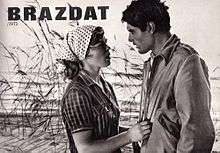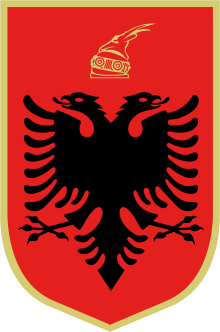Cinema of Albania
The cinema of Albania had its start in 1911—1912, with the first showings of foreign films and the recording of a few documentaries in the pre-war and inter-war period.[1]
During socialist times, the Albanian Film Institute that later became known as Kinostudio Shqipëria e Re was founded with Soviet assistance, focusing mostly on propaganda of wartime struggles. Growing isolationism in the 1970s and 1980s stifled cinematographic imports and fostered domestic productions, which was diversified to various genres, including cultural documentaries and animated films. By 1990, about 200 movies had been produced, and Albania had over 450 theaters, though most of the equipment was obsolete. With the economic transition in the 1990s, Kinostudio was broken up and privatised. A new National Center of Cinematography was established, while cities built modern cinema theatres showing mostly American movies.
Early years
The first public showing to occur in Albania was a little-known title, Paddy the Reliable, a comical story detailing the afterlife events of a man who was so distracted by trivial matters that he was unable to attend his own funeral. These showings of foreign films began in the cities of Shkodër and Korçë. The first Albanian films were mostly documentaries; the first was about the Monastir Congress that sanctioned the Albanian alphabet in 1908.
The Communist period

After World War II, the communist government founded the Albanian Film Institute in 1945, which became Kinostudio Shqipëria e Re in 1952. This was followed by the first Albanian epic film, Skënderbeu, a cooperation with Soviet artists chronicling the life and fight of Albanian national hero Skanderbeg. The film won an award from the Cannes Film Festival. Other known films from the time are Fëmijët e saj (Her sons) and Tana. Tana was the first feature film with a kissing scene in the history of Albanian cinema.
In the 1960s, films concentrated mostly on the subject of the World War II occupation of Albania by Italian and German armies and the fight for liberation. The movies had a strong positive connotation towards the communist partisans and a bad connotation toward the forces of Balli Kombëtar, and they were viewed as state propaganda. Some of the directors of the time were Dhimitër Anagnosti, Viktor Gjika, Gëzim Erebara, and Piro Milkani.
In the 1970s, there was a drastic reduction in the number of imported movies as a result of the cultural and political isolationist campaign by the state. This resulted in an increase of the production in movies to five or six a year early on, and up to eight or ten a year by the end of the decade, peaking at 14 movies a year in the 1980s. Genres were also diversified to include dramatic as well as family and children's movies. Movies of the time were Beni ecën vetë, directed by Xhanfize Keko in 1975, and the comedy Kapedani, directed by Fehmi Hoshafi and Muharrem Fejzo in 1972. A new cadre of directors of the time was composed by Rikard Ljarja, Sajmir Kumbaro, Ibrahim Muçaj, Kristaq Mitro, and Esat Mysliu. This period also marked the start of artistic and made-for-TV movies such as Udha e shkronjave, directed by V. Prifti in 1978.
Some Albanian movies made during the 1980s were Ballë për ballë, directed by Kujtim Çashku and Pirro Milkani in 1979; Dora e ngrohtë, directed by Kujtim Çashku in 1983; Agimet e stinës së madhe, directed by Albert Minga in 1981; Kohë e largët, directed by Spartak Pecani in 1983; and Tela për violinë, directed by Bujar Kapexhiu in 1987.
In the 1970s and 1980s, 20-40 documentaries were produced that dealt in cultural elements as well as propaganda. This period also saw the birth of animated films, with Zana dhe Miri by V. Droboniku and T. Vaso in 1975. Animated films numbered around 16 a year.
These cinematic works were the result of a great cooperative effort by the Kinostudio, various directors, writers, composers, and actors, as well as influences by the state that formed an entire industry. By 1990, about 200 movies had been produced.
By the end of the 1980s, Albania had over 450 theaters. However, most of the equipment was aging and disintegrating.
Post Communist films
.jpg)
During the 1990s, the change of the communist form of government to a capitalist one led to a big change in the Albanian cinema. The big conglomerate Kinostudio of old was broken up into several smaller studios, movies started to be produced in private studios by the old directors, and even some foreign ones were made, but in conjunction with the new National Center of Cinematography (Qendra Kombëtare e Kinematografisë).
Although new movies are being produced, many Albanians have returned to watching and enjoying the old movies, now shown on various private television stations. The old propagandistic elements are now more a source of comedy than hate, and the early style is much appreciated.
Some of the most acclaimed recent movies include Kolonel Bunker, Slogans, Dasma e Sakos, Tirana Year Zero, Porta Eva and the most successful Amnesty.
In the late 1990s, many new cinema theaters were built, especially in the bigger cities (such as "Millennium" in the capital city of Tirana) that mostly show western and more prominently American movies.
See also
- Cinema of the world
- Cinema of Kosovo
- Culture of Albania
- History of Albania
- List of cinema of the world
- List of Albanian films
- Albanian Central Film Archive
- Norman Wisdom, British comedian whose films were highly popular in Communist Albania
- World cinema
References
External links
- Central State's Film Archive
- National Center of Cinematography
- Abdurrahim Myftiu
- A selection of great Albanian movies offered by tanmarket.com (website in Albanian)
- History of the Albanian Cinema, a chronography from TheAlbanians.com (website in English)
- Albanian Film Database - Albanian films, cast, and crew
- Movie Movie - a chronological history of Albanian cinema from 1911 to the present day
- The Albanian Cinema Project - an initiative launched in 2012 by an international group of filmmakers, archivists and film scholars to help bring much needed attention to the cause of preserving, restoring and making accessible Albania's rich film legacy
